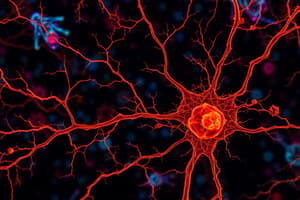Podcast
Questions and Answers
What is the main function of cerebrospinal fluid (CSF)?
What is the main function of cerebrospinal fluid (CSF)?
CSF acts as a buoyancy aid and cushion for the brain, as well as facilitating the delivery of oxygen and nutrients to a local area.
How does CSF provide buoyancy to the brain?
How does CSF provide buoyancy to the brain?
CSF fills the subarachnoid space and allows the brain to float, reducing its effective weight.
What is the normal range of intracranial pressure (ICP)?
What is the normal range of intracranial pressure (ICP)?
The normal range of ICP is 120-180 mmCSF or 9-14 mmHg.
What can significantly raise ICP?
What can significantly raise ICP?
What is the procedure used to measure ICP?
What is the procedure used to measure ICP?
What are the normal values for CSF analysis in the L3-4 interspace?
What are the normal values for CSF analysis in the L3-4 interspace?
What can high protein levels in CSF indicate?
What can high protein levels in CSF indicate?
What can a cloudy appearance of CSF indicate?
What can a cloudy appearance of CSF indicate?
What can yellow color of CSF indicate?
What can yellow color of CSF indicate?
What are the circumventricular organs and their significance?
What are the circumventricular organs and their significance?
Explain the concept of blood brain barrier and its importance.
Explain the concept of blood brain barrier and its importance.
What are the different mechanisms by which substances can move across the capillary membrane into the brain?
What are the different mechanisms by which substances can move across the capillary membrane into the brain?
Explain the process of passive diffusion and its factors of influence.
Explain the process of passive diffusion and its factors of influence.
What is the role of astrocytes in the blood brain barrier?
What is the role of astrocytes in the blood brain barrier?
What is the function of cerebrospinal fluid?
What is the function of cerebrospinal fluid?
Name the different compartments where cerebrospinal fluid is found.
Name the different compartments where cerebrospinal fluid is found.
What causes the movement of cerebrospinal fluid within the brain?
What causes the movement of cerebrospinal fluid within the brain?
What is the rate of production of cerebrospinal fluid?
What is the rate of production of cerebrospinal fluid?
How is cerebrospinal fluid reabsorbed from the subarachnoid space?
How is cerebrospinal fluid reabsorbed from the subarachnoid space?
How often does cerebrospinal fluid turnover occur?
How often does cerebrospinal fluid turnover occur?
Flashcards are hidden until you start studying
Study Notes
Cerebrospinal Fluid (CSF) and Blood Brain Barrier
Functions and Characteristics of CSF
- The main function of CSF is to provide buoyancy to the brain, supporting its weight and cushioning it from mechanical injuries.
- CSF provides buoyancy by reducing the brain's weight, making it approximately 2% of its original weight.
- The normal range of intracranial pressure (ICP) is 5-15 mmHg.
Measuring ICP and CSF Analysis
- The procedure used to measure ICP is through a lumbar puncture or ventriculostomy.
- Normal values for CSF analysis in the L3-4 interspace include:
- Clear appearance
- Protein levels: 20-50 mg/dL
- Glucose levels: 50-80 mg/dL
- Cell count: 0-5 WBC/mL
CSF Abnormalities and Indications
- High protein levels in CSF can indicate:
- Inflammation
- Infection
- Tumor
- Hemorrhage
- A cloudy appearance of CSF can indicate:
- Infection
- Inflammation
- A yellow color of CSF can indicate:
- Hemorrhage
- High bilirubin levels
Blood Brain Barrier (BBB) and Astrocytes
- The blood brain barrier (BBB) is a selective barrier that separates the brain from the bloodstream, regulating the exchange of substances between the two.
- The BBB is composed of endothelial cells, basal lamina, and astrocyte endfeet.
- Astrocytes play a crucial role in the BBB, forming a tight junction with endothelial cells and regulating the transport of substances.
- Mechanisms of substance transport across the capillary membrane include:
- Passive diffusion
- Facilitated diffusion
- Active transport
- Factors influencing passive diffusion include:
- Concentration gradient
- Lipid solubility
- Molecular size and shape
CSF Production, Reabsorption, and Turnover
- CSF is produced at a rate of approximately 500 mL/day.
- CSF is reabsorbed from the subarachnoid space through arachnoid villi.
- The entire CSF turnover occurs every 5-7 hours.
Circumventricular Organs and Compartments
- Circumventricular organs are specialized brain regions that lack a BBB, allowing for the exchange of substances between the brain and bloodstream.
- CSF is found in the following compartments:
- Ventricles
- Cerebral aqueduct
- Subarachnoid space
- Central canal of the spinal cord
- The movement of CSF within the brain is caused by:
- Cerebral pulsations
- Respiratory movements
- Cardiac pulsations
Studying That Suits You
Use AI to generate personalized quizzes and flashcards to suit your learning preferences.




